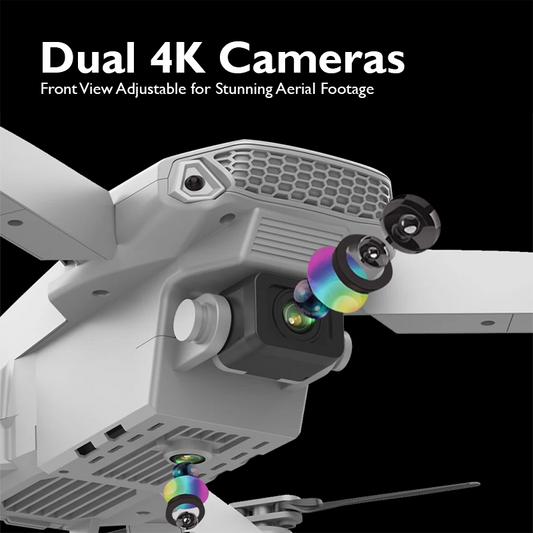Autonomous Drone Fleets: Future Transportation

In the rapidly evolving landscape of transportation, the integration of cutting-edge technologies is reshaping the way we envision the future. One such groundbreaking innovation is the advent of Autonomous Drone Fleets, a concept that holds immense promise for revolutionizing transportation as we know it. This article explores the exciting prospects of Autonomous Drone Fleets, shedding light on their potential impact and the transformative journey that lies ahead.
The Rise of Autonomous Drone Fleets

Autonomous Drone Fleets, also known as Unmanned Aerial Vehicle (UAV) fleets, represent a paradigm shift in the transportation sector. These fleets consist of drones equipped with advanced artificial intelligence and machine learning capabilities, allowing them to operate independently without human intervention. The rapid advancements in drone technology, coupled with sophisticated navigation systems, have paved the way for the deployment of these fleets across various industries.
Key Benefits of Autonomous Drone Fleets
1.Efficient Last-Mile Delivery:

One of the most promising applications of Autonomous Drone Fleets is in last-mile delivery. Drones can navigate through traffic and congested urban areas with ease, significantly reducing delivery times. This efficiency not only enhances customer satisfaction but also reduces the environmental impact associated with traditional delivery methods.
2.Enhanced Surveillance and Security:

Autonomous drones play a pivotal role in bolstering surveillance and security measures. With the ability to cover vast areas swiftly, drones can monitor critical infrastructure, borders, and public spaces, providing real-time data to security agencies. This proactive approach enhances overall safety and response capabilities.
3.Precision Agriculture:

In the agricultural sector, Autonomous Drone Fleets can be employed for precision farming. Equipped with sensors and cameras, drones can analyze crop health, detect diseases, and optimize irrigation patterns. This data-driven approach not only increases crop yields but also promotes sustainable farming practices.
4.Search and Rescue Operations:

The agility and versatility of autonomous drones make them invaluable in search and rescue missions. Equipped with thermal imaging cameras and sensors, these drones can cover expansive areas, locate missing persons, and transmit crucial information to rescue teams.
5.Traffic Management:

Urban congestion is a growing concern in many metropolitan areas. Autonomous Drone Fleets can assist in managing traffic by providing real-time data on road conditions, accidents, and alternative routes. This information enables authorities to optimize traffic flow and reduce congestion.
The Future of Transportation

As we look ahead, the integration of Autonomous Drone Fleets into mainstream transportation holds the key to unlocking unprecedented possibilities. Here are some key aspects that define the future of transportation with the advent of these innovative fleets:
1.Urban Air Mobility:
The concept of Urban Air Mobility (UAM) envisions a future where autonomous drones operate in urban airspace, transporting people and goods between locations. This revolutionary approach has the potential to alleviate traffic congestion, reduce commute times, and redefine the way we navigate our cities.
2.Integration with Smart Cities:
Autonomous Drone Fleets will seamlessly integrate with the evolving landscape of smart cities. These fleets will play a crucial role in creating interconnected transportation systems, optimizing resource utilization, and enhancing overall efficiency in urban environments.
3.Environmental Sustainability:
The environmental impact of traditional transportation methods, especially in terms of carbon emissions, is a growing concern. Autonomous Drone Fleets, powered by electric propulsion systems, present a more sustainable alternative. As the technology evolves, these fleets have the potential to significantly reduce the carbon footprint associated with transportation.
4.Collaboration with Autonomous Vehicles:
The synergy between Autonomous Drone Fleets and ground-based autonomous vehicles is a critical aspect of the future transportation ecosystem. Integrated systems that combine air and ground transportation will offer comprehensive solutions for logistics, emergency services, and public transportation.
5.Regulatory Challenges and Solutions:
The widespread adoption of Autonomous Drone Fleets necessitates the development of robust regulatory frameworks. Governments and aviation authorities worldwide are actively working on establishing guidelines and standards to ensure the safe and responsible integration of drones into airspace.
Challenges and Considerations

While the future of transportation with Autonomous Drone Fleets appears promising, several challenges and considerations must be addressed for seamless integration:
1.Airspace Management:
Effectively managing urban airspace to avoid collisions and ensure the safe operation of Autonomous Drone Fleets is a complex challenge. Developing sophisticated air traffic management systems will be crucial in facilitating the coexistence of drones with manned aircraft.
2.Security Concerns:
As drones become more ubiquitous, the potential for misuse or security breaches increases. Robust encryption, authentication, and anti-hacking measures are essential to safeguard against unauthorized access and protect the integrity of data transmitted by Autonomous Drone Fleets.
3.Public Perception and Acceptance:
Overcoming public concerns and gaining acceptance for the widespread use of drones in urban areas is a significant hurdle. Education and awareness campaigns, coupled with transparent communication about the benefits and safety measures, will play a vital role in shaping public perception.
Autonomous Drone Fleets represent a pivotal chapter in the evolution of transportation, offering innovative solutions to age-old challenges. The future holds exciting possibilities, from streamlined last-mile deliveries to urban air mobility that transforms the way we navigate our cities. While challenges exist, the ongoing efforts to address regulatory concerns and enhance safety measures underscore the commitment to realizing the full potential of this transformative technology.
As we stand at the cusp of a new era in transportation, the integration of Autonomous Drone Fleets signifies not just a technological leap but a paradigm shift that will redefine the way we connect, commute, and experience the world around us. Embracing the potential of Autonomous Drone Fleets is not just about adopting a new mode of transportation; it's about embracing a future where efficiency, sustainability, and innovation converge to create a transportation landscape that is smarter, safer, and more connected than ever before.
Explore a variety of drones at our online drone store.Happy Flying!











